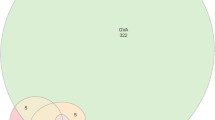Abstract
The purpose of the present study is to determine if there is a relationship between red flag laws and mass shootings. Mass shootings may be averted if the potential shooter’s firearms are seized per a warrant emanating from a red flag statute. Using a fixed effects model and a propensity score matching model, it was found that red flag laws are not significantly related to the number of mass shooting victims (killed and injured). One potential reason for this result is the rarity of mass shootings and the infrequency with which red flag laws are used. Data used in the present study are for the period 1999 to 2020. Mass shootings data were obtained from the Mother Jones mass shooting database. The present study is the first study in the English language literature to examine the relationship between red flag laws and mass shootings.
Similar content being viewed by others
References
Bjelopera, J., Bagalman, E., Caldwell, S., Finklea, K., & McCallion, G. (2013). Public mass shootings in the united states: selected implications for federal public health and safety policy. Congressional Research Service. https://crsreports.congress.gov/product/details?prodcode=R43004. Accessed October 2023.
Blau, B., Gorry, D., & Wade, C. (2016). Guns, laws, and public shootings in the United States. Applied Economics, 48(49), 4732–4746.
Chapman, S., Alpers, P., Agho, K., & Jones, M. (2006). Australia’s 1996 gun law reforms: Faster falls in firearm deaths, firearm suicides, and a decade without mass shootings. Injury Prevention, 12(6), 365–372.
DiMaggio, C., Avraham, J., Berry, C., Bukur, M., Feldman, J., Klein, M., Shah, N., Tandon, M., & Frangos, S. (2018). Changes in US mass shooting deaths associated with the 1994–2004 federal assault weapons ban: Analysis of open-source data. Journal of Trauma and Acute Care Surgery, 86(1), 11–19.
Duwe, G., Kovandzic, T., & Moody, C. (2002). The impact of right-to-carry concealed firearm laws on public mass shootings. Homicide Studies, 6(4), 271–296.
Everytown for Gun Safety. (2023). Extreme risk laws save lives. https://everytownresearch.org/report/extreme-risk-laws-save-lives. Accessed October 2023.
Follman, M., Aronsen, G., & Pan. D., (2023). US Mass Shootings, 1982–2023. Mother Jones. https://www.motherjones.com/politics/2012/12/mass-shootings-mother-jones. Accessed October 2023.
Fridel, E. (2021). Comparing the impact of household gun ownership and concealed carry legislation on the frequency of mass shootings and firearms homicide. Justice Quarterly, 38(5), 892–915.
Gius, M. (2020). Using the synthetic control method to determine the effects of firearm seizure laws on state-level murder rates. Applied Economic Letters, 27(21), 1754–1758.
Gius, M. (2019). Self-protective behaviors in the united states: Results from a recent survey. International Journal of Applied Economics, 16(1), 43–54.
Gius, M. (2015). The impact of state and federal assault weapons bans on public mass shootings. Applied Economics Letters, 22(4), 281–284.
Holmes, R., & Holmes, S. (1992). Understanding mass murder: A Starting Point. Federal Probation, 56(1), 53–61.
Klarevas, L., Conner, A., & Hemenway, D. (2019). The effect of large-capacity magazine bans on high fatality mass gun shootings, 1990–2017. American Journal of Public Health, 109(12), 1754–1761.
Kleck, G. (2016). Large-capacity magazines and casualty counts in mass shootings: The plausibility of linkages. Justice Research and Policy, 17(1), 28–47.
Koper, C. S., & Roth, J. (2001). The impact of the 1994 federal assault weapons ban on gun violence outcomes: An assessment of multiple outcome measures and some lessons for policy evaluation. Journal of Quantitative Criminology, 17(1), 33–74.
Kivisto, A., & Phalen, P. L. (2018). Effects of risk-based firearm seizure laws in connecticut and indiana on suicide rates, 1081–2015. Psychiatric Services, 69(8), 855–862.
Kwon, R., & Cabrera, J. (2019). Socioeconomic factors and mass shootings in the united states. Critical Public Health, 29(2), 138–145.
Lemieux, F. (2014). Effect of gun culture and firearm laws on gun violence and mass shootings in the united states: A multi-level quantitative analysis. International Journal of Criminal Justice Sciences, 9(1), 74–93.
Lott, J. & Landes, W. (2000). Multiple victim public shootings. Social Science Research Network. http://papers.ssrn.com/sol3/papers.cfm?abstract_id=272929. Accessed October 2023.
National Center for Injury Prevention and Control, Centers for Disease Control. (2023). Fatal injury reports, https://www.cdc.gov/injury/index.html. Accessed October 2023.
National Institute on Alcohol Abuse and Alcoholism, National Institutes of Health. (2023). Total per capita alcohol consumption in gallons of ethanol by state, https://www.niaaa.nih.gov/research/surveillance-reports/surveillance117/fig4. Accessed October 2023.
Parker, G. (2015). Circumstances and outcomes of a firearm seizure law: Marion county, indiana, 2006–2013. Behavioral Science and the Law, 33(2–3), 308–322.
Petee, T., Padgett, K., & York, T. (1997). Debunking the stereotype: An examination of mass murder in public places. Homicide Studies, 1(4), 317–337.
Siegel, M., Goder-Reiser, M., Duwe, G., Rocque, M., Fox, J. A., & Fridel, E. (2020). The relation between state gun laws and the incidence and severity of mass public shootings in the united states, 1976–2018. Law and Human Behavior, 44(5), 347–360.
Swanson, J., Norko, M., Lin, H., Alanis-Hirsch, K., Frisman, L., Baranoski, M., Easter, M., Robertson, A., Swartz, M., & Bonnie, R. (2017). Implementation and effectiveness of connecticut’s risk-based gun removal law: Does it prevent suicides? Law and Contemporary Problems, 80(2), 179–208.
U.S. Census Bureau. (2023). Current population surveys. https://www.census.gov/programs-surveys/cps/data.html. Accessed October 2023.
Author information
Authors and Affiliations
Corresponding author
Additional information
Publisher's Note
Springer Nature remains neutral with regard to jurisdictional claims in published maps and institutional affiliations.
Rights and permissions
Springer Nature or its licensor (e.g. a society or other partner) holds exclusive rights to this article under a publishing agreement with the author(s) or other rightsholder(s); author self-archiving of the accepted manuscript version of this article is solely governed by the terms of such publishing agreement and applicable law.
About this article
Cite this article
Gius, M. Relationship Between Red Flag Laws and Mass Shootings. Atl Econ J 52, 31–38 (2024). https://doi.org/10.1007/s11293-024-09791-2
Accepted:
Published:
Issue Date:
DOI: https://doi.org/10.1007/s11293-024-09791-2




